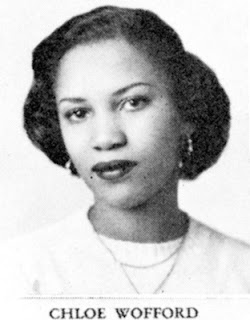Ralph Waldo Ellison (1914-1994), novelist, essayist, and literary critic. Author of Invisible Man, Juneteenth, and Three Days Before the Shooting, and the essay collections Shadow and Act and Going to the Territory.
ASSIGNMENT: You will write a final essay of 6-8 pages, allowing you the luxury of extended thought and discussion of a dominant theme in one of the semester’s readings or on one of the major works we have read (Ex: Passing, The Bluest Eye). This essay will be written utilizing Modern Language Association guidelines. We will have a brief “brainstorming” session on Tuesday, 3/23 to assist you in developing a topic and focus for your final paper.
CORRECTION: THIS PAPER IS DUE ON TUESDAY, 4/20. NO LATE PAPERS WILL BE ACCEPTED. (corrected by Prof. Williams, 3/28/10)
This paper will be due on Tuesday, 4/6. Any paper submitted after this date will result in a loss of 5 points per class meeting day overdue (ex: submitted by Thursday, 4/8 for a possible maximum of 25 pts; submitted by Tuesday, 4/13 for a possible maximum of 20 pts). You may submit your paper early. NO papers will be accepted after Tuesday, 4/13/10.
Sample themes: abolitionism, accommodationism, adventure, aesthetics, alienation, childhood, class distinctions, colorism/color consciousness, community, corporeality, education, equality, family, femininity, feminism, freedom, gender roles, hypocrisy, individuality, integration, intellectualism, interracialism, law, literacy, masculinity, morality, passing, poverty, race relations, racism, radicalism, rebellion, religion, repatriation, responsibility, revolution, science, segregation, separatism, sexism, sexual exploitation, sexuality, slavery, stereotyping, violence. Some of these themes overlap—your thesis should reflect your theme in a clear, well-articulated manner.
The paper will follow MLA guidelines in matters of form (see MLA in-text citation style below—for complete MLA style, click at left on course blog), and it will contain a Works Cited Page, in-text citations to those sources, and a complete outline.
If you wish to (not mandatory), you may turn in a typed draft of the research paper by Thursday, 4/1 for a quick review. This will be quickly scanned during class for structure and documentation and returned to you. You must use a total of ten (10) in-text citations from at least five (5) sources, in any combination, for your essay.
For this final research paper, YOU MAY NOT USE the following as sources, as they are NOT considered scholarly works: SparkNotes, CliffsNotes, ClassicNotes, Enotes, GradeSaver, or any other student guides.
A Wikipedia entry may NOT be used as a source—however, if the “Source” section of a Wikipedia entry contains a scholarly work (a journal article or academic book) that you want to quote from in your paper, you are free to retrieve the work from the library (hard copy or from a database) and incorporate it into your paper.
YOUR PAPER WILL BE GRADED ON CONTENT AND MECHANICS
(see Student Checklist for Papers).
ANY INSTANCE OF PLAGIARISM IN THE RESEARCH PAPER WILL RESULT IN AN “F” ON THE ENTIRE PAPER WITH NO POSSIBILITY FOR REVISION.
_____________________________________________________________________
SUBMISSION DATES
ABSTRACT: Students must present a one paragraph abstract of approximately 75-100 words summarizing the paper and how he or she plans to proceed, detailing the following: Why you chose it; what is important about it; what you intend to examine; what library resources you intend to use to complete the assignment. Due Tuesday, 3/23
BIBLIOGRAPHY: You must present a Bibliography of sources (books, journal articles, newspaper articles, media sources, Internet sources) that you think you be using for your research paper. The page will consist of no fewer than five (5) outside sources. At least three (3) of the sources must come from scholarly books or articles on the main topic. Internet sources can comprise no more than two (2) of the sources.
Due Tuesday, 3/30
OUTLINE: An outline is required as part of the grade for the research paper. This outline must directly correspond to the research paper.
Due Tuesday, 3/30
DUE DATE for Research Paper (with final Works Cited page): Tuesday, 4/6.
ANY PAPER SUBMITTED AFTER THIS DATE WILL RESULT IN THE LOSS OF 5 POINTS PER CLASS MEETING DAY OVERDUE. NO PAPERS WILL BE ACCEPTED AFTER TUESDAY, 4/13/10. NO EXCEPTIONS. PAPERS MAY BE SUBMITTED EARLY.










